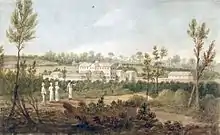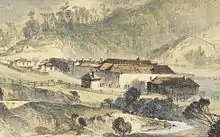Convict women in Australia
Convict women in Australia were British prisoners whom the government increasingly sent out during the era of transportation (1787-1868) in order to develop the penal outpost of New South Wales (now a state of Australia) into a viable colony.
| Part of a series on |
| Women in society |
|---|
 |
These women faced extreme difficulty in achieving freedom, solvency and respectability. They would be employed in ‘factories’ (equivalent of the English workhouse) but often had to find their own accommodation, and would be under great pressure to pay for it with sexual services. In this way, all the women convicts tended to be regarded as prostitutes. But it is a popular misconception that they had originally been convicted of prostitution, as this was not a transportable offence.
Background
Owing to industrialisation and the growth of city-slums, as well as the unemployment of soldiers and sailors following the American War of Independence, England was experiencing a high crime rate around 1780. The prisons were overcrowded; there was no attempt to segregate the prisoners by their offence, age or sex.
In response to growing crime, the British government began to issue harsh punishments such as public hangings or exile. During the 18th and 19th centuries many prisoners were transported to Australia to carry out their sentence, a relatively small percentage of whom were women (between 1788 and 1852, male convicts outnumbered the female convicts six to one[1]). Convict women varied from small children to old women, but the majority were in their twenties or thirties. The British Government called for more women of “marriageable” age to be sent to Australia in order to promote family development for emancipated convicts and free settlers.
Despite the belief that convict women during the transportation period were all prostitutes, no women were transported for that offence. The majority of women sent to Australia were convicted for what would now be considered minor offences (such as petty theft), most did not receive sentences of more than seven years. Many women were driven to prostitution upon their arrival in Australia as means of survival because they were often required to house themselves or buy clothing and bedding on their own.
Convict population of New South Wales during the period
| Year | Males | Females | Total |
|---|---|---|---|
| 1788[2] | 529 | 188 | 717 |
| 1790[2] | 297 | 70 | 367 |
| 1800[2] | 1,230 | 328 | 1,558 |
| 1805[2] | 1,561 | 516 | 2,077 |
| 1819[2] | 8,920 | 1,066 | 9,986 |
| 1828[2] | 16,442 | 1,544 | 17,986 |
| 1836[2] | 25,254 | 2,577 | 27,831 |
| 1841[2] | 23,844 | 3,133 | 26,977 |
Voyage
The First Fleet was the first set of ships to transport convicts to Australia, it sailed in 1787. Ships continued to transport convicts to Western Australia until 1868. The beginning of the transportation years brought ships at inconsistent times and the death rate on these ships remained high; in the Second Fleet, 267 out of 1,006 prisoners died at sea. However, at the peak of transportation, the death rate was a little more than one percent.[3]
Ralph Clark, an officer on board the Friendship in the First Fleet, kept a journal of his journey to Australia. In his journal, he described the women on board as "abandoned wenches", contrasting their characteristics with the supposed virtues of his wife in England.[4] At one stage, after several male convicts were caught in the place where the female convicts were lodged, Clark wrote: "I hope this will be a warning to them from coming into the whore camp — I would call it by the Name of Sodem [sic] for ther[e] is more Sin committed in it than in any other part of the world".[5]
Elizabeth Fry's British Ladies Society cared for women convicts. They had a convict ship sub-committee that persuaded the Navy board to fund "gifts" for the transportees. These items included knives, forks, aprons and sewing materials.[6] During the 25 years that Fry was involved 12,000 women were transported on 106 ships. The society's plan was to visit every ship on the night before it sailed to calm the women.[7] William Evans, the surgeon of the "Lady of The Lake" noted the valuable worth of the Ladies Society and he singled out Pryor and Lydia Irving's work for praise.[8]
Some seamen developed relationships with the women whilst on the voyage. Women used their bodies as a way of bettering their conditions. On the Lady Juliana, a ship in the Second Fleet, female convicts began to pair off with the seamen. John Nicol, a Scottish steward recalled, "Every man on board took a wife from among the convicts, they nothing loath."[9] These relationships were not always just . Nicol himself expresses his desire to marry and bring back to England his convict "wife", Sarah Whitlam, after her release.
Female factories


Female factories in Australia housed convict women who were awaiting assignment, pregnant or undergoing punishment. They were called factories because the women were expected to work and because they also employed free working women. Task work was established in female factories in 1849, requiring the occupants to do chores, needle-work and washing. If extra work was done, the convict's sentence might be shortened.[10] Punishments for misconduct in the factories were often humiliating, a common one was to shave the woman's head.
Conditions in these factories were miserable. In the Parramatta female factory the occupants were not given mattresses or blankets to sleep on and the social conditions inside were indecent.
The Parramatta female factory was the first built in Australia and was located in Parramatta, New South Wales. The factory had room for only a third of the female prisoners; the rest had to find lodgings with the local settlers at some cost (usually about four shillings a week).[11] Many women could only pay for this cost by offering sexual services. Their customers were usually the male convicts who came and left the factory as they pleased.
In 1819 Macquarie had ex-convict Francis Greenway create a new design for the factory. This new design had the inmates divided into three categories: the "general", "merit" and "crime" class.[12] The "crime" class women had their hair cropped as a mark of disgrace and were the incorrigibles. The "merit" or first class comprised women who had been well behaved for at least six months and women who had recently arrived from England. These girls were eligible to marry and eligible for assignment. The second or "general" class was made up of women who were sentenced for minor offences and could be transferred to the first class after a period of probation. This class consisted of many women who had become pregnant during their assigned service. The factory at Parramatta was a source of wives for settlers and emancipated convicts. With a written permit from the Reverend Samuel Marsden and a written note to the matron, a bachelor could take his pick of a willing "factory lass."
Family and marriage
Marriage between male and female convicts and raising a family was encouraged because of the government’s intentions of developing a free colony. It was the objective of the British government to establish a colony in Australia rather than have it remain as a penal settlement. This compelled the government to send more women to Australia as a way of establishing a native population. On the arrival of 'female' ships, colonists would swarm to the dock to bargain for a servant. High-ranking officers had first pick. Some women were taken as mistresses, others as servants. There were no legal ties for these assignments, so a settler could dismiss a convict woman freely. When this did occur, it created a class of woman who often resorted to prostitution in order to feed and house themselves properly.
Male convicts had the chance to select a bride from the female factories by a system called 'convict courtship'. The male convicts came to the female factories to inspect the women, who had to line up for the occasion. If the male convict saw a woman that he liked, he made a motion at her to signal that he wanted to choose her. Most women accepted the offering. This process was often described as similar to the one in which slaves were selected.[13]
The Reverend Samuel Marsden categorized the women convicts into being married or prostitutes. If a woman were to have a relationship out of wedlock, Marsden considered this whoredom. Many couples lived and cohabited together monogamously without being officially married, yet these women were recorded as being prostitutes. The women were scarred from being convicted and could not redeem their status because it differed so greatly from the British ideal of a woman, who was virtuous, polite and a woman of the family.
List of notable convict women
Legacy
Mary Reibey has featured on the obverse of Australian twenty-dollar note since 1994.
The Incredible Journey of Mary Bryant, a British-Australian film based on the life of Mary Bryant, was released in 2005.
Notes
- Hughes 244
- Summers 275
- Hughes 145
- Hughes, Robert (1987). The Fatal Shore. New York City: Alfred A. Knopf. p. 97. ISBN 0-394-75366-6.
- The Journal and Letters of Lt. Ralph Clark – The University of Sydney. Retrieved 19 November 2012.
- Amanda Phillips, ‘Irving, Lydia (1797–1893)’, Oxford Dictionary of National Biography, Oxford University Press, 2004 accessed 20 June 2017
- William H. Beveridge (27 November 2014). Voluntary Action (Works of William H. Beveridge): A Report on Methods of Social Advance. Routledge. p. 166. ISBN 978-1-317-57299-2.
- Anne Isba (1 July 2010). The Excellent Mrs Fry: Unlikely Heroine. A&C Black. pp. 88–. ISBN 978-1-84725-039-1.
- Hughes 251
- Female Factory Research Group, "Hobart Town Female Factory" Archived July 20, 2008, at the Wayback Machine
- Hughes 255
- Hughes 256
- Damousi, Joy (1997). Depraved and Disorderly. Cambridge University Press. ISBN 0 521 58323 3.
References
- Daniels, Kay, and Mary Murnane. Uphill All the Way. St. Lucia, Queensland: University of Queensland Press, 1980.
- "Female Factories." Female Factory Research Group. 15 Aug 2008. Female Factory Research Group 15 Oct 2008.
- Hughes, Robert. The Fatal Shore. New York: Vintage Books, 1988.
- Rees, Sian. The Floating Brothel. London: Headline, 2001. ISBN 0747272867
- Summers, Anne. Damned Whores and God's Police. New York: Penguin Books, 1975.
External links
- Cascades Female Factory Historic Site — "Australia’s most significant historic site associated with female convicts"
- Female Convicts Research Centre — a non-profit dedicated to research "into the lives and experiences of convict women and their children in Van Diemen’s Land"
- Parramatta Female Factory Precinct — "Australia's first purpose built convict Female Factory and Roman Catholic Orphan School"